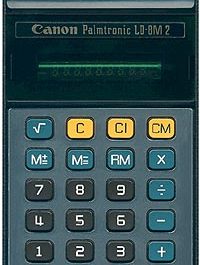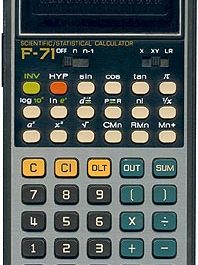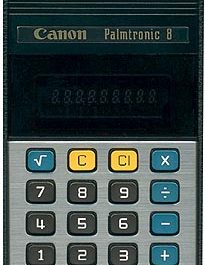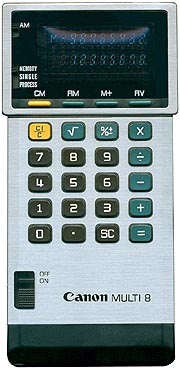
The Canon Palmtronic Multi 8 (MD-8) was an advanced calculator for its time, released in 1977. It featured a unique dual display system with an 8 digit upper display and 8 digit lower display. The upper display showed the full calculation as it was entered, while the lower display showed the result. This allowed users to see their entire calculation at a glance, a feature not common until graphing calculators much later.
The MD-8 measured approximately 73x155x20mm and weighed 154g without batteries. Power came from 3 AA batteries or an optional AC adapter. The black plastic case had aluminum keyboard surrounds and neutral density filter over the displays. Keys used individual keycaps in a style similar to Casio calculators.

The dual vacuum fluorescent tube displays were a major technical achievement, though likely a battery drain. The upper display had room for a 9th digit to indicate negative numbers or memory, while the lower display used the 9th digit for errors.
Features included the four basic math functions, square root, percentages, sign change, register exchange, and a simple 3-register memory. The memory could accumulate automatically. A 3-position mode switch allowed use of dual displays, single lower display, or constant memory display.
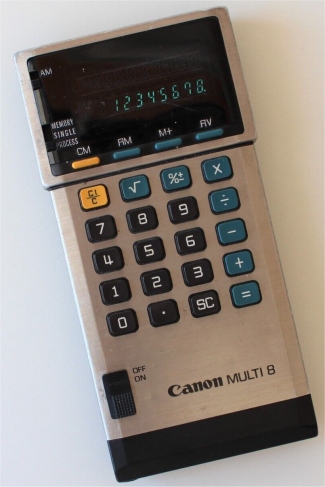
Logic
- CI/C) cancels an incorrect numerical entry, pressing a second time clears the calculator
- Input overflow is suppressed, typing in nine digits ignores the ninth
- There is automatic constant on multiply and divide only
- Negative numbers are shown by a minus in the immediate left digit travelling into the far left (ninth) digit thereby allowing full eight digit negative numbers.
- The (SC) change sign function can be used in mid number entry
- Divide by zero results in zero and an “E” in the far left (ninth) digit and is not recoverable
- Overflow shows the result with “E” in the far left (ninth) digit and is not recoverable
- Memory store is indicated with a “M” in the far left (tenth) position of the upper display except in single mode (see below) when you have to remember it yourself!
- (RV) is register exchange and swaps the two numbers in an operation. It is not a memory control even though it is clustered with the other memory keys.
- Negative square roots are not allowed, result is show with an error and is not recoverable
- There is a switch labelled “AM” for automatic (or accumulation) memory. When this is set on every result of the “=” key is added to the memory.
There is a three way switch to set the operation of the calculator:
- Process shows the dual line calculation display; Keying in (6)(X)(9) shows “6” in the upper display, “9” in the lower display and “X” in the lower display’s far left (tenth) digit. The latter digit can show “-“, “÷”, or “+”.
- Single puts the calculator into single (lower) display mode only – just like a normal calculator. I guess this was put in to conserve batteries.
- Memory where the contents of the memory is constantly displayed in the upper display. The “M” character in the tenth digit position is always on in this mode even when the memory is zero
Canon later replaced the MD-8 with the simpler Palmtronic LE-8 using a single display. However, the MD-8 represented an innovative milestone in handheld calculator design. Its use of dual displays foreshadowed graphing calculators and influenced how calculators displayed information. Although ahead of its time, the MD-8 gave a glimpse of user-friendly calculated designs to come.
